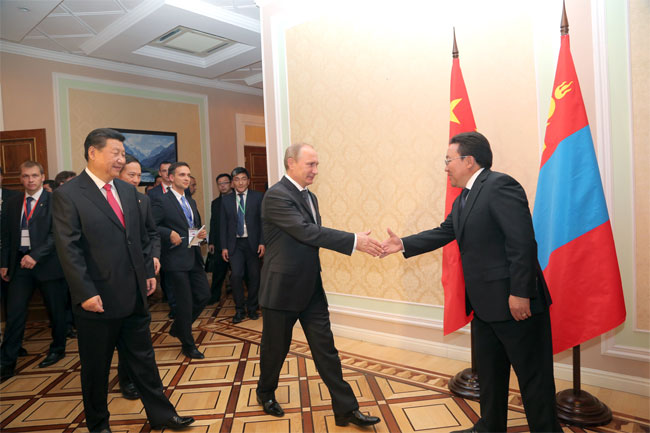Memo #318
By Mendee Jargalsaikhan – mendee [at] alumni.ubc.ca
 Last autumn, Presidents Xi Jinping and Vladimir Putin made separate visits to Mongolia, met for a tri-lateral (Russia-China-Mongolia) summit in the Tajikistan capital of Dushanbe during the leadership summit of the Shanghai Cooperation Organization (SCO), and dispatched their vice-foreign ministers for a working-level meeting in preparation for next year’s summit in Ufa, Russia. With only a very brief amicable period between these three neighbors during the 1950s, China’s and Russia’s recent constructive behavior is new, even anomalous. What might it mean?
Last autumn, Presidents Xi Jinping and Vladimir Putin made separate visits to Mongolia, met for a tri-lateral (Russia-China-Mongolia) summit in the Tajikistan capital of Dushanbe during the leadership summit of the Shanghai Cooperation Organization (SCO), and dispatched their vice-foreign ministers for a working-level meeting in preparation for next year’s summit in Ufa, Russia. With only a very brief amicable period between these three neighbors during the 1950s, China’s and Russia’s recent constructive behavior is new, even anomalous. What might it mean?
China and Russia have competed over Mongolia for centuries. As a result, greater Mongolia was shattered into two major geopolitical entities—Inner Mongolia, which is now part of the PRC, and Outer Mongolia, an independent nation-state. Both Mongolias served as geo-strategic buffer zones during the Sino-Soviet split of the 1960s. Even in the post-Cold War period, China and Russia avoided any joint collaboration over Mongolia. As a result, major infrastructure projects like railroad and power plants became hostages of the geopolitical and economic competition of Mongolia’s two larger neighbours. A ten-year debate over the railroad extension in Mongolia—about whether to use Chinese or Russian standard gauges—was just one salient example. Earlier, Mongolia’s neutrality was supported by Russia, but no longer.
The joint move of China and Russia indicates a new dynamic in Inner Asia. Russia’s complicated geopolitical competition in Europe is compelling Russia into a more junior partner position in Sino-Russian interactions. Unable to resist Chinese political and economic expansions in Inner Asia, Russia has acquiesced to cooperation with China on infrastructure development projects in Mongolia, and even presented no objections to using Chinese standard rail gauges for railroad expansion in Mongolia. And Russia now supports strengthening the SCO by the inclusion of Mongolia, whose presence is vital to fill the awkward hole in the SCO’s map for regional legitimacy. These changes are transforming Mongolia from a buffer zone to a zone of Sino-Russian convergence.
About the Author:
Mendee Jargalsaikhan is a PhD student in the Department of Political Science at the University of British Columbia, and an Institute of Asian Research Fellow for 2013-2014. You can visit his personal blog on Mongolia at http://blogs.ubc.ca/mongolia/.

The heads of state of China, Russia and Mongolia meet in Dushanbe, Tajikistan in September 2014 (credit: infomongolia.com).
Links:
- Sergey Radchenko, “Sino-Russian Competition in Mongolia,” The Asan Forum (Sep-Oct 2014)
- Alan Wachman, “Mongolia: Growth, Democracy, and Two Wary Neighbours,” Policy Q & A (National Bureau of Asian Research) (May 2012)
- Jeffrey Reeves, “Mongolia’s Evolving Security Strategy: Omni-enmeshment and Balance of Influence,” The Pacific Review 25:5 (2012)
- “Russia, China & Mongolia Begin Trilateral Talks,” The Diplomat (October 2014)
- “Why Russia, China, & Mongolia Are Boosting Trilateral Ties,” The Diplomat (September 2014)
- Alicia Campi, “Transforming Mongolia-Russia-China Relations: The Dushanbe Trilateral Summit,” The Asia-Pacific Journal 12:44, No. 1 (November 10, 2014)
[…] the permission of the Asia Pacific Memo of the Institute of Asian Research, for the original memo, Memo #318 […]
[…] Mongolia – From Sino-Russian Buffer to Conversion Zone | Asia Pacific Memo. Memo #318 By Mendee Jargalsaikhan – mendee [at] alumni.ubc.ca Last autumn, Presidents Xi Jinping and Vladimir Putin made separate visits to Mongolia, met for a tri-lateral (Russia-China-Mongolia) summit in the Tajikistan capital of Dushanbe during the leadership summit of the Shanghai Cooperation Organization (SCO), and dispatched their vice-foreign ministers for a working-level meeting in preparation for next year’s summit in Ufa, Russia. […]